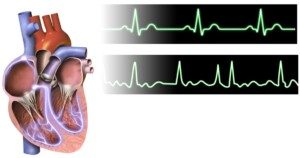
Since atrial fibrillation isn’t guaranteed to occur in any given 24-hour period, isn’t it logical to conclude that a Holder monitor could miss it?
What exactly is atrial fibrillation?
Atrial fibrillation (AFib) is a heart rhythm disorder characterized by rapid and irregular electrical activity in the atria, the heart’s upper chambers.
This irregularity leads to an erratic heartbeat, which can cause symptoms like palpitations, fatigue and shortness of breath.
AFib increases the risk of stroke and heart failure if untreated.
If you were to view the number on a heart rate screen of a person with this heart arrhythmia, you would not see a steady number.
A normal heartbeat would show a steady number, give or take a few, such as a consistent range of 78 to 81.
If someone is in the midst of atrial fibrillation, you’d be seeing the numbers jumping all over the place quite quickly.
One moment the range might be high 70’s. Next moment it’s jumping around between 140 and 170.
Then suddenly it’s between 100 and 120. Then suddenly it’s 85, then 150. You get the picture.

A-fib. BruceBlaus
If a doctor or you yourself suspect atrial fibrillation, and the next step is to wear a Holter monitor, you may then think that this won’t necessarily be an effective way of tracking the heart rhythm disorder — since the atrial fibrillation may be quiet during the time you have on the Holter device.
“Atrial fibrillation can occur at varying frequency and is often not associated with symptoms,” says Norman E. Lepor, MD, cardiologist and internal medicine specialist Norman E. Lepor, MD, who’s with Cedars Sinai in Beverly Hills, CA.
“If it occurs less often than every 24 hours it can be missed on a Holter monitor,” he adds.
“Longer-term monitoring devices that can be monitoring for weeks to years can be used in those cases.”
So if the Holter device shows no abnormalities…this in no way means you don’t have A-fib.
Your doctor will tell you that you need to wear an event monitor that tracks heart rhythm for a longer period of time.
This device records your heart’s electrical activity continuously or at specific intervals to help diagnose irregularities or abnormal rhythms that may not be picked up by a Holter monitor.
Untreated atrial fibrillation is a major risk factor for an ischemic stroke.










































